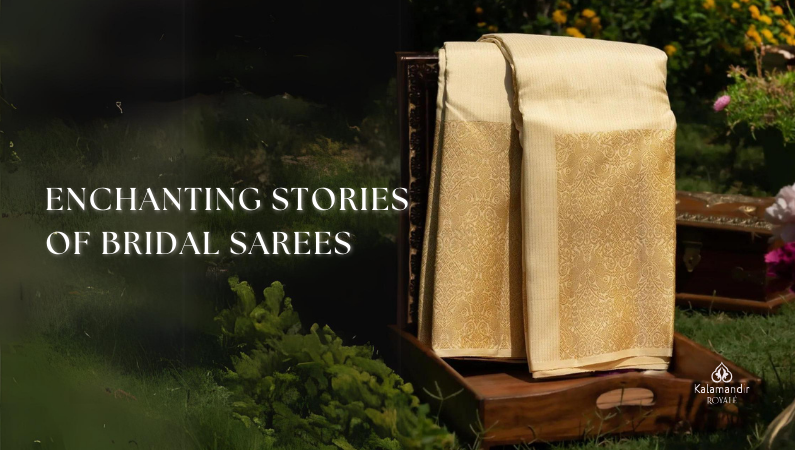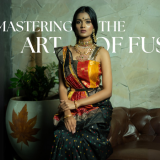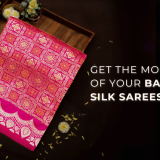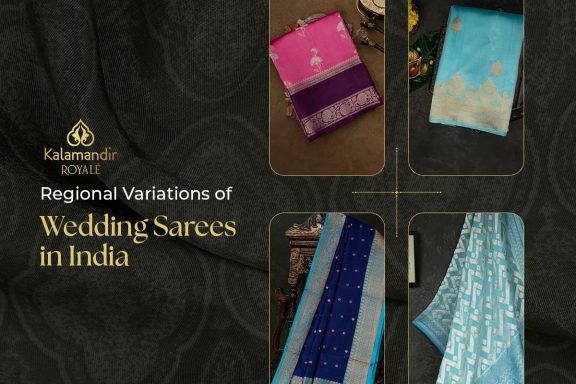Bridal sarees are not mere eye-catching wedding attire; they are cultural artifacts, each filled with tales rich in history, passed through generations. The intricate patterns, vivacious hues, and exquisite materials narrate unique stories of love, culture, and heritage. In this post, we shall unearth the mysteries and fascinating narratives wrapped within bridal sarees, highlighting their value and significance in wedding trousseaus. Brace yourself for an entrancing journey into the universe of bridal sarees, as we unfold their concealed tales.
Decoding the Fascinating Mysterious Beauty of Bridal Sarees
Bridal sarees are truly a sight to behold, with their ethereal beauty and captivating allure. But what is it that makes them so mysterious? What lies beneath their exquisite fabrics and intricate designs?
The beauty of a bridal saree lies not just in its aesthetic appeal, but also in the stories it holds. Each saree is like a canvas, telling tales of love, tradition, and culture. The motifs, patterns, and colors are carefully chosen to symbolize blessings, fertility, and prosperity. They reflect the values and beliefs of the communities from which they originate.
Decoding the mysterious beauty of bridal sarees means understanding the layers of meaning behind each element. The elaborate embroidery and handiwork that adorns these sarees is a testament to the skill and craftsmanship of artisans. Each thread is meticulously woven, forming a tapestry that speaks of heritage and tradition.

The choice of fabric is also crucial in enhancing the allure of a bridal saree. Silk, for instance, is a popular choice due to its lustrous texture and ability to drape gracefully. Different regions have their own signature styles of weaving, such as the intricate Kanjivaram silk sarees of South India or the delicate Banarasi silk sarees of North India.
The mysterious beauty of bridal sarees lies not just in their outward appearance, but in the stories they carry. They are a symbol of love, tradition, and the enduring spirit of a community. So the next time you see a bride draped in a stunning saree, remember that there is much more to it than meets the eye.
The Stories Woven in Bridal Sarees
Bridal sarees are not just pieces of fabric; they are intricate stories woven together. Each thread and pattern carries a rich history, passing down tales of love, tradition, and culture. The stories behind these sarees are as enchanting as the sarees themselves, making them truly unique and special.
The motifs and designs on a bridal saree hold deep significance. They symbolize blessings, fertility, and prosperity, reflecting the values and beliefs of the community. For example, the peacock motif represents beauty and grace, while the lotus symbolizes purity and enlightenment. Every pattern and element is carefully chosen to tell a story and invoke powerful emotions.
Behind the stunning fabric and embroidery lies the skill and craftsmanship of artisans. Each saree is a labor of love, with every thread meticulously woven. It is a testament to the artistry and talent of these craftsmen, who carry forward generations of traditions.
As you unwrap the layers of a bridal saree, you uncover a tapestry of love and heritage. The stories woven in bridal sarees connect generations, passing down the wisdom and spirit of a community. So, when you witness a bride donning a beautiful saree, remember that you are witnessing the culmination of countless stories and traditions coming together in one breathtaking moment.
The Evolution and Modern Interpretation of Bridal Sarees
Over the years, bridal sarees have gone through an evolution, adapting to the changing times while still maintaining their essence and cultural significance. Traditional bridal sarees were often heavy and ornate, adorned with intricate embroidery and embellishments. They were a symbol of opulence and grandeur.
However, as times changed, so did the preferences of brides. Modern interpretations of bridal sarees now embrace a more minimalist and contemporary approach. Lighter fabrics such as chiffon and georgette are used to create sarees that are easy to wear and comfortable for the bride. The emphasis is now on elegance and simplicity, with clean lines and subtle embellishments.

In addition to the change in fabrics and designs, the color palette of bride sarees has also evolved. While red and gold were traditionally the go-to colors for bridal sarees, brides now have a wide range of options to choose from. Pastel shades, vibrant hues, and even unconventional colors such as blues and greens are gaining popularity.

The modern interpretation of bridal sarees also takes into account the preferences and personalities of the bride. Designers now work closely with brides to create customized sarees that reflect their individuality. Brides have the option to experiment with different draping styles, mix and match fabrics, and even incorporate modern elements such as lace or sequins.
The evolution and modern interpretation of bridal sarees showcase the adaptability of this timeless garment. It demonstrates that while tradition and cultural significance are important, there is also room for creativity and personal expression. The bridal saree continues to be a symbol of love, tradition, and heritage, but with a modern twist that captures the spirit of the contemporary bride.
The Artistic Techniques Behind Bridal Sarees
The artistry behind bridal sarees is truly mesmerizing. From the intricate embroidery to the delicate handiwork, each saree is a masterpiece in its own right. The artisans who create these sarees employ a variety of artistic techniques to bring them to life.
One of the key techniques used in bridal sarees is zari work. This involves weaving metallic threads, usually gold or silver, into the fabric. The shimmering effect created by zari work adds a touch of luxury and elegance to the saree. Another technique commonly used is threadwork, where different types of threads, such as silk or cotton, are embroidered onto the fabric to create beautiful motifs and patterns. The skill and precision required for threadwork is truly remarkable.
Other artistic techniques used in bridal sarees include sequin work, mirror work, and beadwork. These embellishments are carefully added to the saree to enhance its beauty and create a stunning visual impact. The placement and arrangement of these elements require a keen eye for detail and a steady hand.
Each region in India has its own unique artistic techniques that are used in the creation of bridal sarees. For example, the intricate kantha embroidery of West Bengal, the delicate mirror work of Rajasthan, and the vibrant bandhani tie-dye technique of Gujarat all contribute to the diversity and richness of bridal sarees.
The artistic techniques behind bridal sarees are a testament to the skill and craftsmanship of the artisans. Their dedication and expertise ensure that each saree is a work of art that will be treasured for generations to come.
Captivating Colors and Patterns of Bridal Sarees
When it comes to bridal sarees, the colors and patterns are truly captivating. These vibrant and eye-catching elements add a sense of joy and celebration to the bride’s special day. From rich reds and vibrant yellows to soft pastels and intricate motifs, bridal sarees come in a wide array of colors and patterns that reflect the diverse cultural heritage of India.
The colors chosen for a bridal saree often have symbolic meaning. Red, for example, is considered auspicious and is commonly associated with marriage and fertility. Gold, on the other hand, represents wealth and prosperity. Other popular colors include shades of pink, purple, and blue, each with their own significance.
In addition to the colors, the patterns on bridal sarees are equally mesmerizing. Intricate motifs such as paisley, peacock, floral, and geometric designs are commonly found. Each pattern tells a story and adds a unique touch to the saree. The skill and craftsmanship required to create these intricate patterns is truly impressive.
Whether it’s a traditional saree with intricate zari work or a modern saree with contemporary prints, the captivating colors and patterns of bridal sarees are sure to leave a lasting impression. They not only enhance the beauty of the bride but also showcase the rich cultural heritage of India. So, the next time you see a bride adorned in a stunning saree, take a moment to appreciate the captivating colors and patterns that make it a true work of art.






